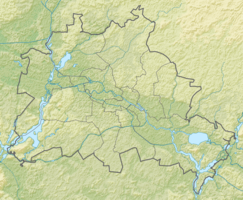Bird sanctuary on Wildmeisterdamm in Rudow
|
LSG bird sanctuary on Wildmeisterdamm in Rudow
|
||
|
Bird sanctuary at Wildmeisterdamm |
||
| location | Berlin , Germany | |
| surface | 3.75 ha | |
| Identifier | LSG-04 | |
| WDPA ID | 325431 | |
| Geographical location | 52 ° 25 ′ N , 13 ° 28 ′ E | |
|
|
||
| Setup date | March 8, 1952 | |

The bird sanctuary on Wildmeister dam in Rudow is a 3.75 hectare large landscape conservation area (LSG) in the Berlin district of Gropiusstadt (area formerly in the district of Rudow ) of the Neukölln district belongs. It is also known as the bird forest or bird sanctuary .
history
The forest was laid out in 1872 by game master Hugo Luther on behalf of Kaiser Wilhelm I as a game depot. Up to 1000 hares and 900 partridges could be shot in the annual court hunts. William I appointed Luther then to the royal Wildmeister and named the former Buckower Chaussee in 1939 in his honor posthumously in Wildmeister dam to. In the 1920s and 1930s, however, its importance as a hunting area diminished, as the population of wild animals declined sharply due to the increasing population of the surrounding area. The hunt was finally stopped with the ban for all of Berlin in 1945. Parallel to this development, the later director of the Neukölln local history museum, Wilhelm Schmidt, had been trying to designate the area as a bird sanctuary since 1929 . This took place in 1934. In 1952, the police chief of Berlin, Johannes Stumm , placed it under landscape protection.
The area underwent massive encroachment with the construction of the Berlin Wall . The GDR insisted that the route of the Neukölln-Mittenwalder Railway no longer ran in GDR territory, but had to be moved further west into the bird sanctuary. This required extensive tree felling work in the area. Further interventions took place through the construction of the Sollmannweg, the Friedrich-Kayßler-Weg and the work on the underground line 7 . With the construction of Gropiusstadt , the site was integrated into the newly planned area. To improve the living environment, the area was redesigned into a landscape park in 1987 according to plans by the landscape planners Müller / Knippschild / Wehberg. The forest was fenced in in order to "prevent trampling paths with the resulting soil compaction and to create new growth opportunities for natural undergrowth and herbs." The landscape protection area has been embedded in the Neukölln garden culture path since 2006 .
fauna and Flora
In the area there are numerous tree species such as birch , oak , linden , chestnut , poplar , but also elm and bird cherry . In addition, 46 species of birds have survived from Schmidt , 26 of which are still breeding in the area today.
See also
Individual evidence
- ↑ walter - Nachrichten aus der Gropiusstadt , 53rd edition, January / February 2012, (PDF, 893 kB), accessed on November 6, 2012.
- ^ Chronicle: Berlin in 1952 , website of the Luisenstädtischer Bildungsverein, accessed on November 4, 2012.
- ↑ a b Das Vogelwäldchen , website of the district management Gropiusstadt, accessed on November 7, 2012.
- ↑ Olaf Pfeifer: The Gropiusstadt - New interpretation of large housing estates from the 1960s , diploma thesis of the TU Berlin, [1] (PDF file; 4,530 kB), accessed on November 4, 2012.
- ↑ Rudower Wäldchen , website of the Garden Culture Path Neukölln, accessed on November 4, 2011.


